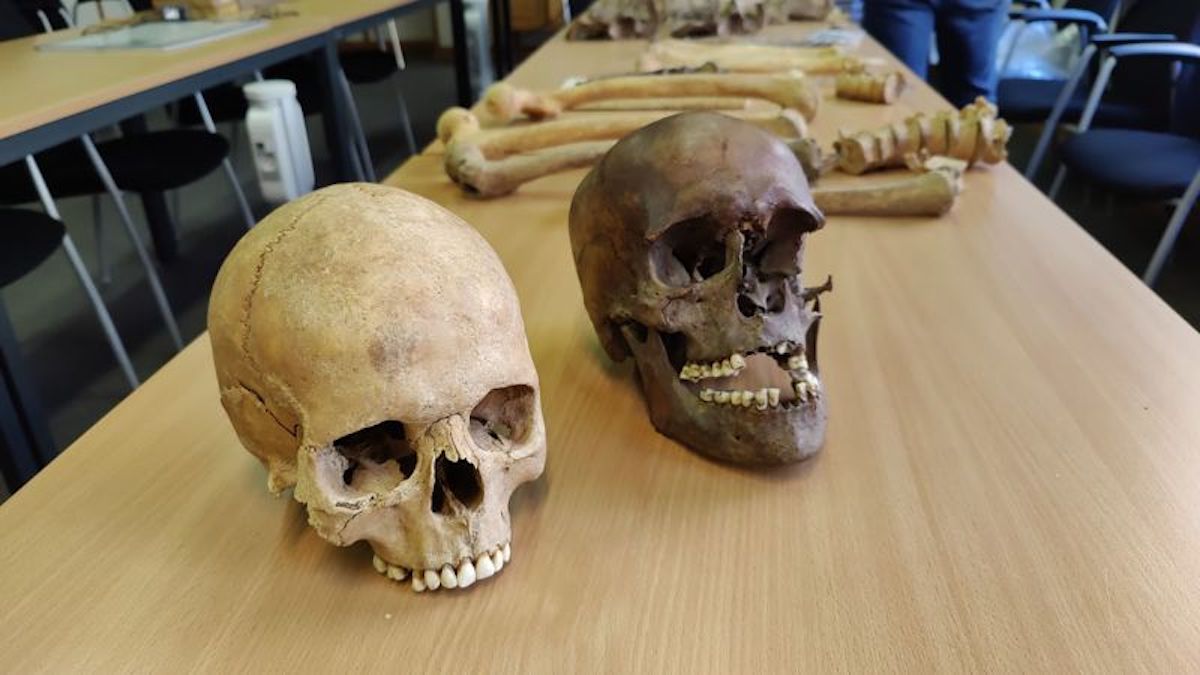Solve 1991 mystery 1:01
(CNN) --
Bones believed to belong to soldiers who died in the Battle of Waterloo have been discovered in an attic in Belgium.
Scientists are now analyzing the human remains to try to learn more about the identity of those who died.
The battle was fought near the village of Waterloo, south of Brussels, on June 18, 1815. Napoleon Bonaparte was finally defeated here by the Duke of Wellington's combined Allied army of 68,000, aided by 45,000 Prussians under Gebhard. von Blucher.
While more than 10,000 men are believed to have died during the battle, only two bodies have been discovered.
The remains of at least six soldiers, some of whom are believed to be British, were discovered by a metal detector.
Courtesy Bernard Wilkin/AWAP
Historians recently revealed that many of those who died at Waterloo were later disinterred by farmers, who sold their remains to the sugar industry for use in the industrial process.
They discover a "golden child"
mummified with 49 precious amulets
Last November, Bernard Wilkin, a senior researcher at the Belgian State Archives, was in Waterloo giving a talk about the process — in which bones are used as a kind of charcoal in purifying sugar — when something amazing happened.
advertising
After the talk, he told CNN, “This old man came up to me and said 'Dr.
Wilkin, I have bones of these Prussians in my attic."
The man, who wishes to remain anonymous, showed Wilkin photographs of the bones and invited him to his home near the battlefield at Plancenoit, where Napoleon's forces clashed with the Prussians.
A few days later, Wilkin visited the man at his home and came face to face with the remains the man had had since the 1980s. He explained that he had a "little private museum" at the time and a friend who had found them. some years earlier he gave her the remains to display.
Despite being a collector of Napoleonic memorabilia, the man told Wilkin that "ethically" he couldn't bring himself to display the remains, so he kept them in his attic.
Wilkin said of the man, who lives alone: "He suddenly decided that he was old and could pass away in the next few years and he was afraid of what would happen to his bones.
When he saw the investigation we published last summer, he thought, "This guy knows about bones and the Napoleonic Wars and he works for the government."
Skulls were found on the second tour in various parts.
Courtesy Bernard Wilkin/AWAP
Wilkin said he felt a "mixture of surprise and excitement" when he saw the wreckage.
"One of the skulls is deeply damaged by a sword or bayonet, so it was a very brutal way to die," he said.
Initial tests revealed that the remains belonged to at least four soldiers.
Items found near the bones, including leather and bone buttons, as well as the location in which they were discovered, suggested that some of the dead were Prussian soldiers.
Wilkin said: “At the end of the day he gave me all the boxes to study.
One of his requests to me was that I bury them in a dignified manner.
That is certainly the plan, but for now the remains are undergoing extensive forensic testing in Liège, where Wilkin is being held.
Scientists hope to extract DNA in an attempt to identify the dead.
They also hope to make facial reconstructions of at least one of the skulls.
Rob Schäfer, a German military historian, is working with Wilkin to try to learn more about the soldiers, while also acting as a liaison with the German War Graves Commission.
He told CNN: "What fascinated me the most is the fact that if you look at 19th century art, where conflict is depicted, it's all very interesting and abstract.
As a casual observer, you might get the impression that it wasn't that bad, but this particular skull with massive facial trauma shows for the first time just how violent the era really was."
Schäfer told CNN there is a 20-30% chance of extracting DNA from the remains.
He said: "It's a long shot, but if we're successful, the next goal is to upload the DNA into databases so people can come forward if they find out they're related."
Two skulls were among the human remains discovered in the Belgian attic.
They showed signs of extreme violence.
Courtesy Bernard Wilkin/AWAP
After finding the bones in the attic, there was another surprise in store for Wilkin.
"When I was visiting, the man told me 'by the way, I have another friend who probably has four British soldiers who he discovered while (metal) detecting next to the Lion's Mound (on the battlefield)," he said.
"I was shocked, this was getting really crazy."
Wilkin told CNN those bones were later examined by Dominique Bosquet, an archaeologist with the Walloon Heritage Agency.
They have since moved to Brussels, where they are being studied by Bosquet and a team from the Museum of Natural History and the University of Brussels.
The findings have led Wilkin and his colleagues to suspect that more people living near the battlefield may have skeletons in their closets.
"It's pretty clear that we need to talk to the people who have lived there for generations," he said, adding: "We're pretty sure more bones should be returned to the Belgian authorities."
waterloo

